Townsend Courtney M.Jr., Evers B. Mark. Atlas of General Surgical Techniques: Expert Consult
Подождите немного. Документ загружается.


1062 Section XIII • Amputations
◆ Posterior laterally, the tensor fasciae latae muscle is incised below the anterior aspect of the
gluteus maximus. This muscle is divided at its insertion to the gluteal tuberosity. The glu-
teus medius and minimus, piriformis, gemellus, and obturator externus muscles are divided
near their insertion to the greater trochanter. The capsule of the hip joint is opened to
expose the neck and head of the femur (see Figure 96-5).
◆ The sciatic nerve is transected high, just below the piriformis muscle, and allowed to retract
beneath this muscle (Figure 96-6). The insertions of the obturator internus and quadratus
femoris to the greater trochanter are divided. The origins of the hamstring muscles are
divided off the ischial tuberosity: semimembranosus, semitendinosus, and long head of the
biceps. The extremity can be removed once the ligamentum capitis femoris is divided
between the head of the femur and the acetabulum (Figure 96-7).
◆ The wound is irrigated and a suction drainage catheter is positioned in the resection bed.
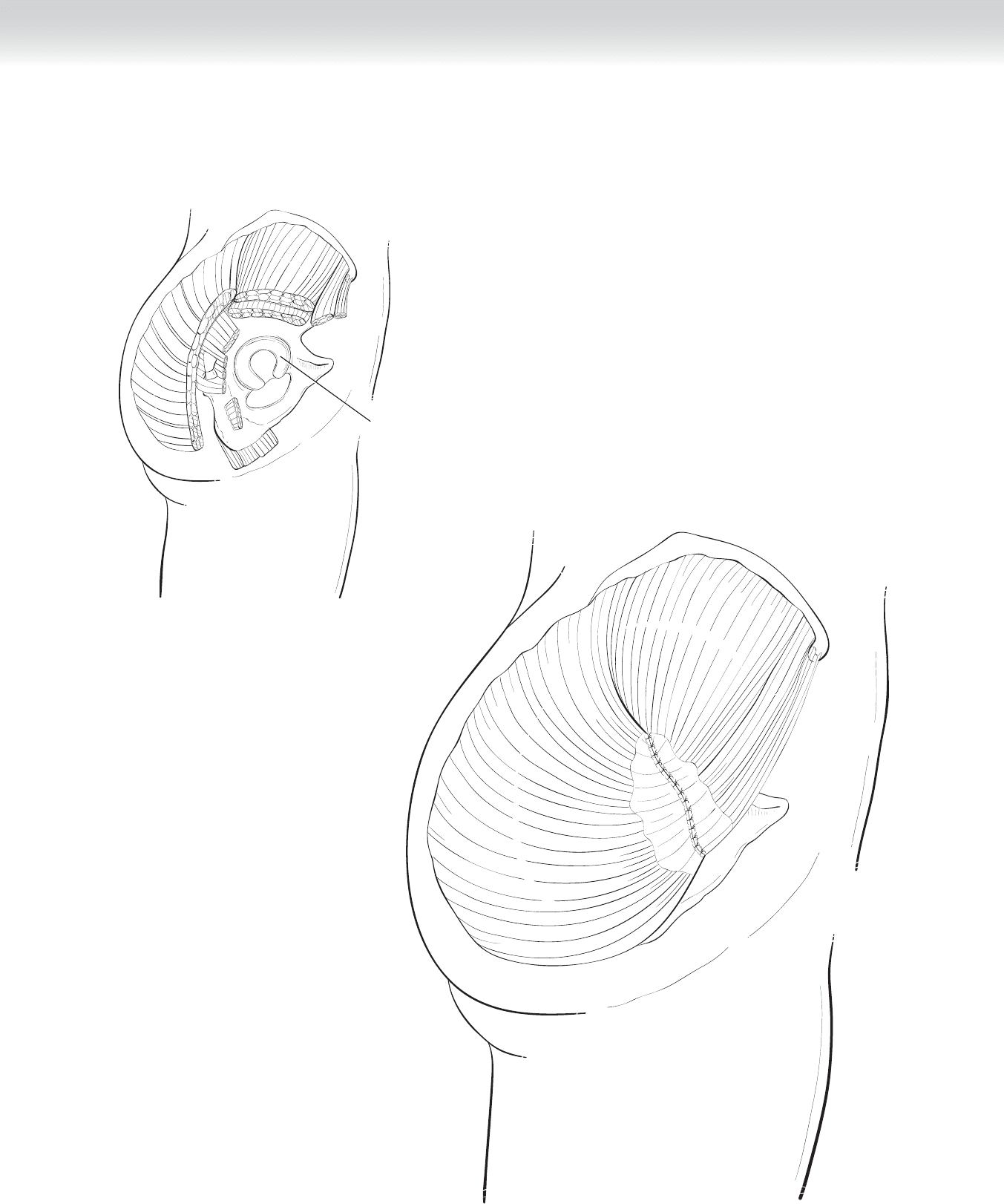
CHAPTER 96 • Hip Disarticulation 1063
Muscle Closure over Acetabulum
FIGURE 96 –7
Acetabulum
Resection Bed
FIGURE 96 –6
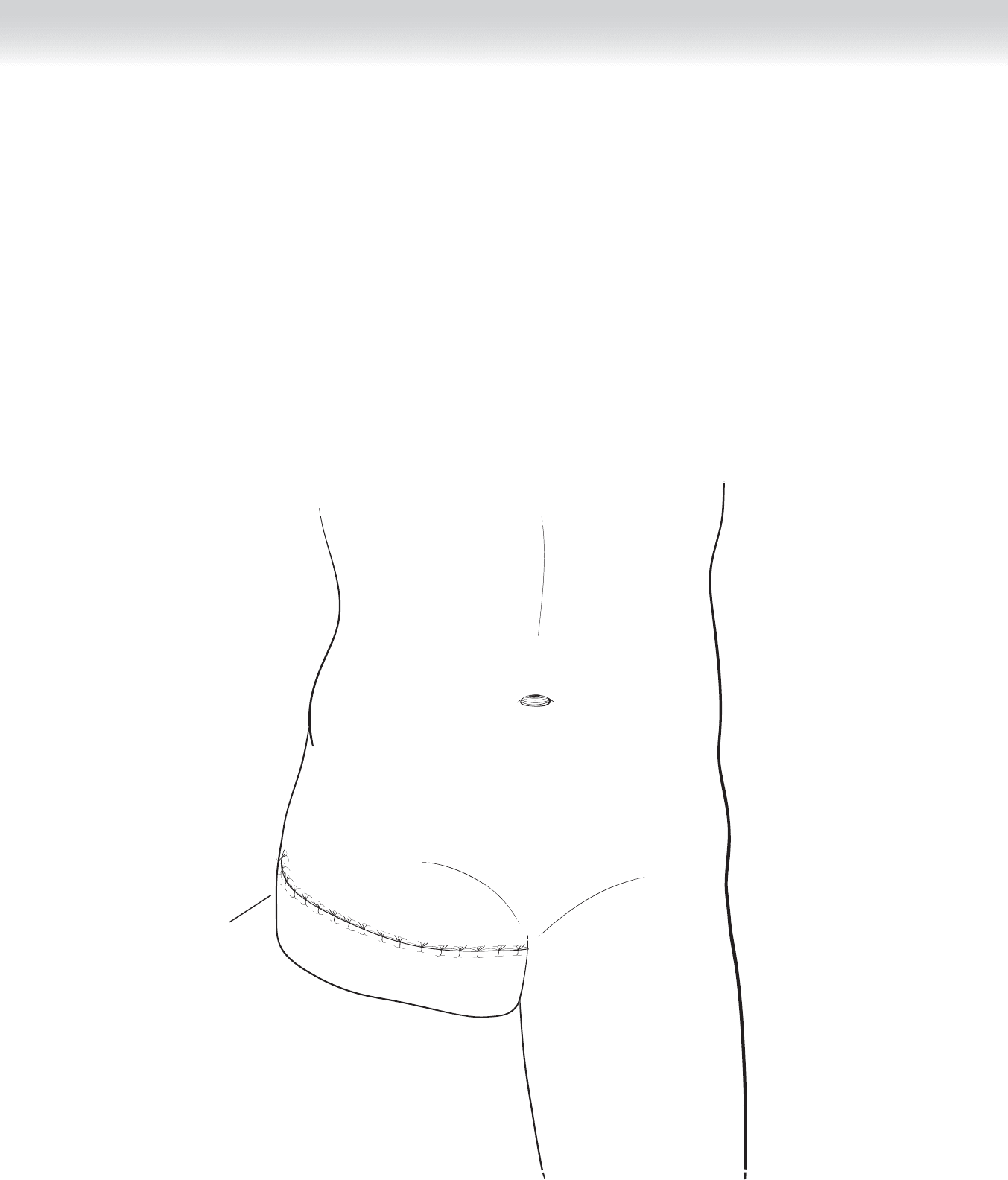
1064 Section XIII • Amputations
3. CLOSING
◆ The posterior muscles (quadratus femoris) can be approximated to anterior muscles
(iliopsoas) to cover the exposed acetabulum using 2-0 Vicryl interrupted absorbable sutures
(see Figure 96-7).
◆ The residual obturator externus and gluteus muscles can be reapproximated together. The
posterior fl ap is longer so that the fl ap can be brought anteriorly and sutured to the anterior
fl ap.
◆ The deeper subcutaneous tissues are fi rst reapproximated, and then the skin can be sutured
or stapled (Figure 96-8). This closure should be tension free to minimize fl ap necrosis.
Skin closure
FIGURE 96 –8

CHAPTER 96 • Hip Disarticulation 1065
STEP 4: POSTOPERATIVE CARE
◆ After the closed-suction drain and sutures are removed, the patient should be fi tted for a
prosthetic limb and referred to physical therapy for early ambulation.
STEP 5: PEARLS AND PITFALLS
◆ When possible, all muscles are transected at their origin or insertion to minimize blood
loss. Viable muscles are used to cover the exposed acetabulum. Phantom limb pain may be
managed in conjunction with experts in pain management and rehabilitation medicine.
SELECTED REFERENCES
1. Boyd HB: Anatomic disarticulation of the hip. Surg Gynecol Obstet 1947;84:346-349.
2. Slocum DB: An Atlas of Amputations. St. Louis, Mosby, 1949.
3. Sugarbaker PH, Nicholson TH: Atlas of Extremity Sarcoma Surgery. Philadelphia, JB Lippincott
Company, 1984.

1068
STEP 1: SURGICAL ANATOMY
◆ Figures 97-1 and 97-2 demonstrate the anatomy of the female pelvis as it pertains to
gynecologic surgery.
◆ The bladder is attached to the anterior lower uterine segment and cervix at the anterior
refl ection of the visceral peritoneum.
◆ The uterine arteries insert into the uterus laterally at the level of the internal cervical os.
◆ The ureters cross over the bifurcation common iliac arteries and are found inferior to the
infundibulopelvic ligament on the medial leaf of the broad ligament. As the ureter con-
tinues on its course to the bladder, it passes under the uterine artery 1 to 2 cm lateral to
the insertion of the uterine artery at the level of the internal cervical os (see Figure 97-1).
◆ Figure 97-2 demonstrates the key ligaments of the uterus.
◆ The infundibulopelvic ligament carries the blood supply to the ovaries.
◆ The utero-ovarian ligament attaches the uterus to the adnexal structures, fallopian tubes,
and ovaries.
◆ Round ligaments are insubstantial anterior lateral attachments of the uterine fundus that
help maintain the normal uterine position.
◆ Cardinal ligaments attach the entire length of the cervix to the pelvic sidewall. These
sturdy ligaments supply most of the uterine support.
◆ Uterosacral ligaments attach the cervix to the sacrum.
CHAPTER
97
Abdominal Hysterectomy
Concepcion Diaz-Arrastia
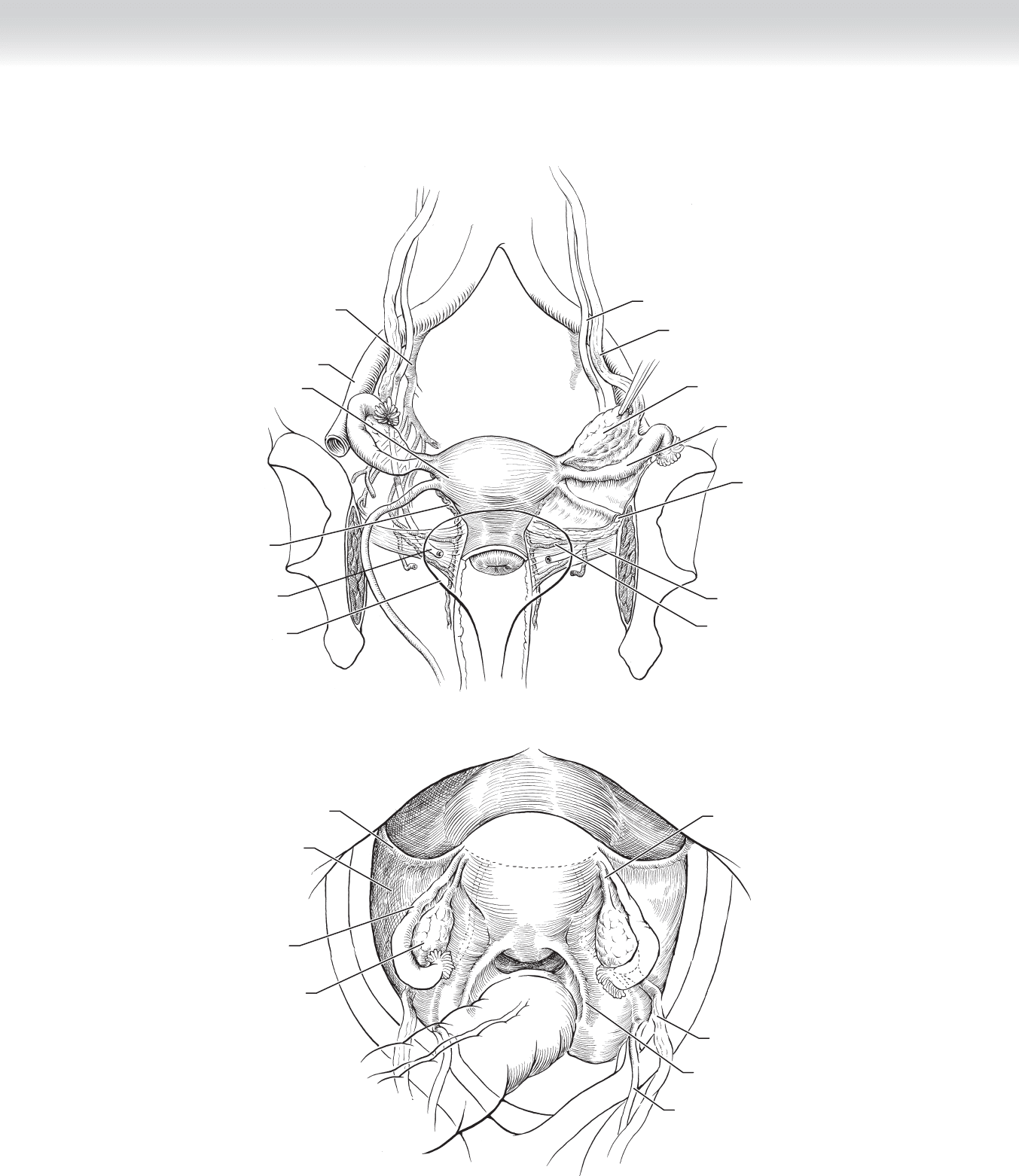
CHAPTER 97 • Abdominal Hysterectomy 1069
Infundibulopelvic ligament
Ureter
Ovary
Fallopian tube
Round ligament
Uterine artery
and ureter
Cardinal ligament
MC
Uterus
Internal iliac
artery
External iliac
artery
Uterine artery
Bladder
Ureter
FIGURE 97 –1
Uterosacral
ligament
Infundibulopelvic
ligament
Ligament of ovary
Uterus
Ovary
Fallopian tube
Round ligament
Broad ligament
Bladder
Bladder
Ureter
FIGURE 97 –2

1070 Section XIV • Gynecology
◆ Figure 97-3 demonstrates the parts of the uterus.
◆ The uterine corpus has two horns laterally.
◆ The internal cervical os is where the uterine arteries enter the uterine body.
◆ The external cervical os is at the junction with the vagina.
◆ Figure 97-4 demonstrates the cervicovesical potential space that separates the bladder from
the cervix.
STEP 2: PREOPERATIVE CONSIDERATIONS
◆ Several laboratory tests should be documented as part of the preoperative evaluation for a
hysterectomy.
◆ Pap smear to exclude invasive cervical carcinoma
◆ Negative pregnancy test in women of reproductive age
◆ Endometrial biopsy revealing no malignancy in a woman with abnormal uterine bleeding
◆ Indications for concomitant bilateral salpingo-oophorectomy (BSO) should be discussed
with the patient. In general, BSO is recommended in any woman older than the age of
40 to 45 years or in a younger woman with familial or hereditary breast or ovarian cancer
risk or severe endometriosis.
◆ Prophylactic antibiotics are indicated because the peritoneal cavity is contaminated by the
vaginal incision to remove the cervix.
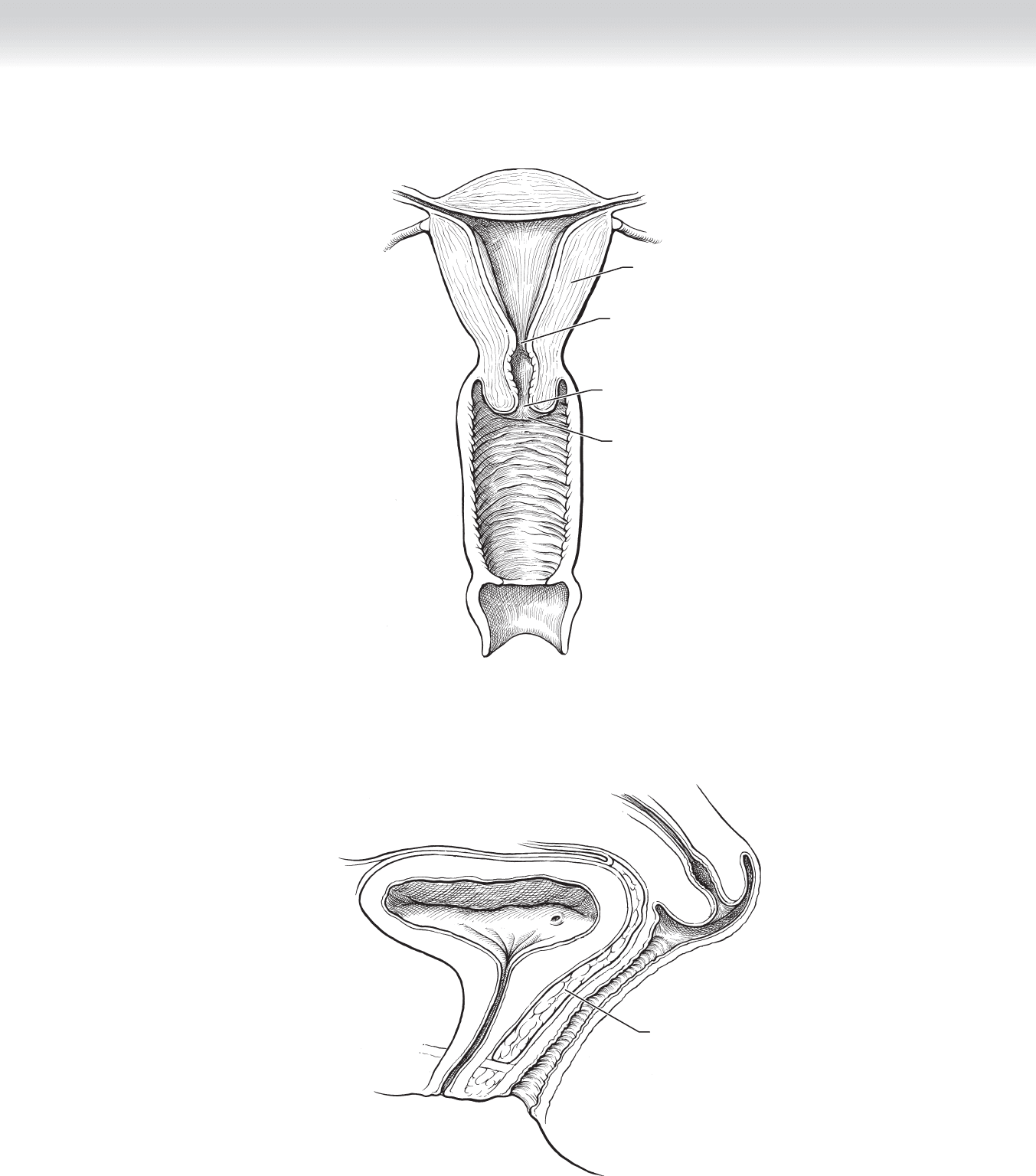
CHAPTER 97 • Abdominal Hysterectomy 1071
Internal os
Uterine corpus
External os
Cervix
Cervicovesical
space
FIGURE 97 –3
FIGURE 97 –4
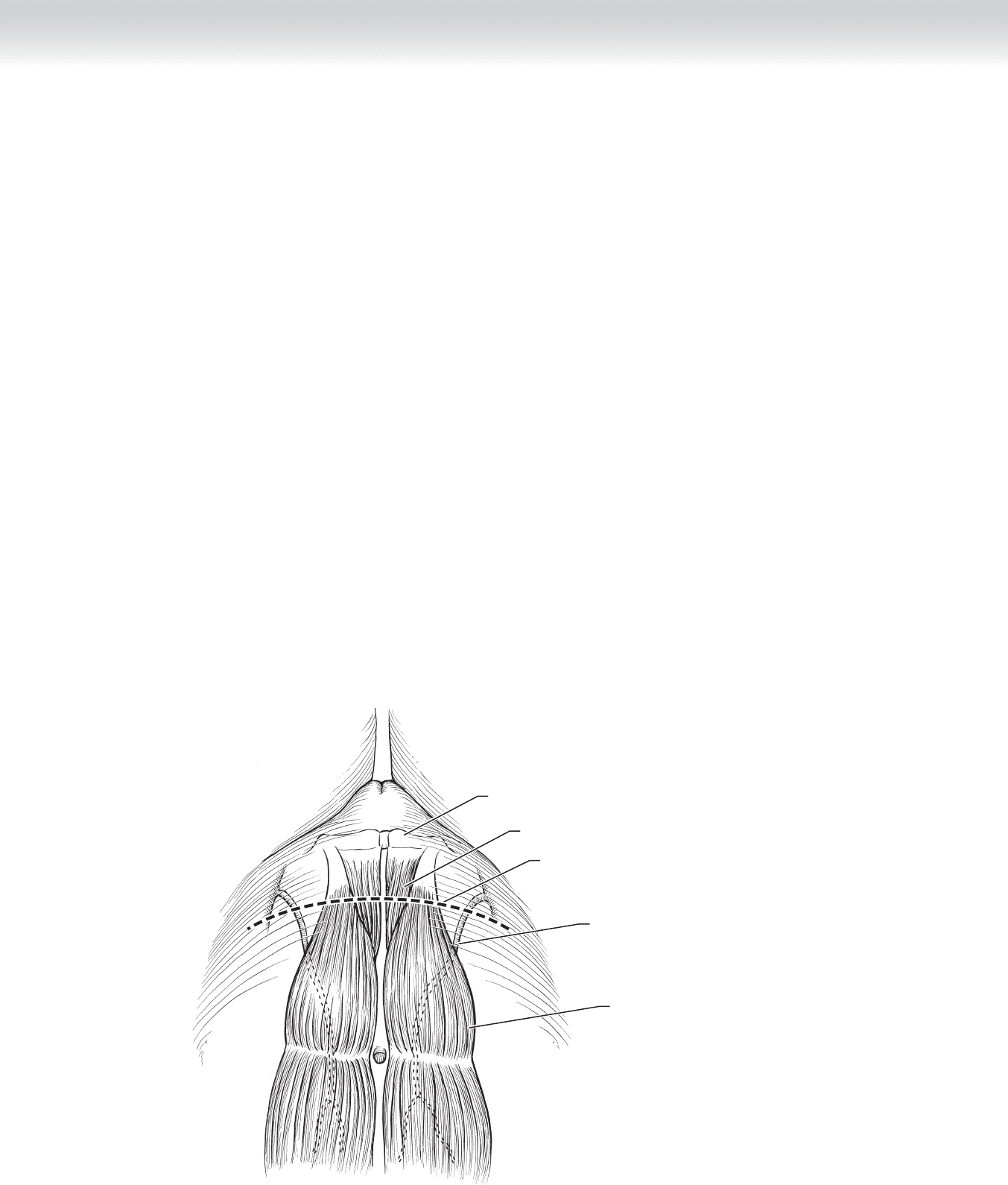
1072 Section XIV • Gynecology
STEP 3: OPERATIVE STEPS
1. INCISIONS
◆ A vertical skin incision allows for excellent exposure, as well as the ability to extend the
incision to the upper abdomen, at the expense of cosmetic result and an increased rate of
wound complications.
◆ A transverse skin incision allows for adequate exposure in the pelvis. Three transverse inci-
sions are available to the pelvic surgeon, depending on the body habitus of the patient and
the uterine pathology. Figure 97-5, A, depicts the skin incision for all transverse incisions,
1 to 2 cm above the symphysis pubis extending approximately 6 cm to both sides of the
rectus abdominis muscles. This incision is carried down to the anterior rectus sheath or
fascia (Figure 97-5, B). The fascia is then incised, also transversely, for the length of the
incision. After the fascial incision, the procedures diverge.
◆ The Pfannenstiel skin incision is the most popular transverse skin incision and is appropri-
ate for removal of a normal-sized uterus. The rectus muscles are dissected from the anterior
rectus sheath in both the cephalad and caudad directions (Figure 97-5, C). The posterior
rectus sheath is then opened vertically at the midline (Figure 97-5, D), the rectus muscles
are retracted laterally, and the exposed peritoneum is opened the length of the incision to
expose the pelvis.
Pubic tubercle
Pyramidalis muscle
Pfannenstiel incision
Inferior epigastric artery
Rectus abdominis muscle
A
FIGURE 97–5
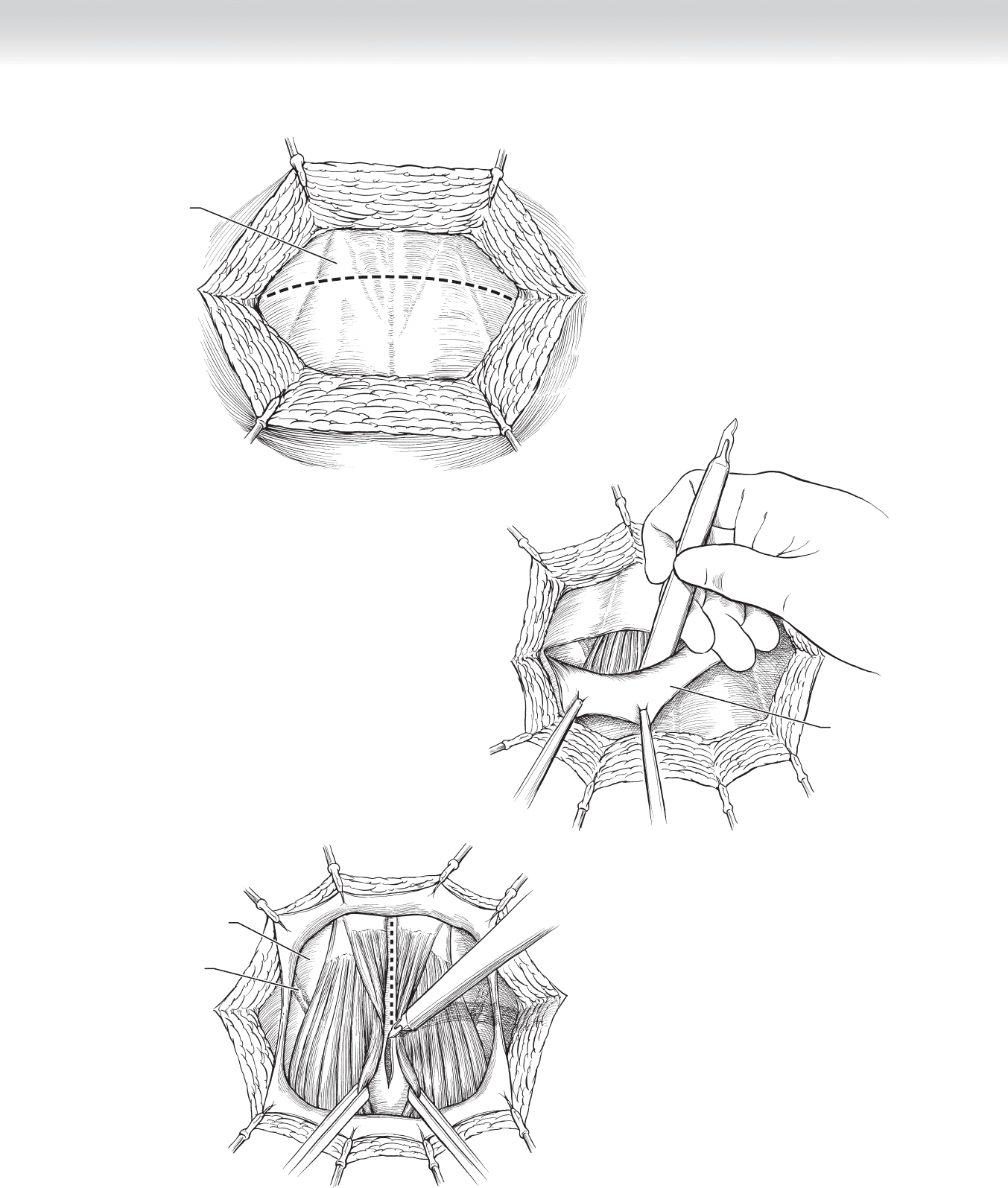
CHAPTER 97 • Abdominal Hysterectomy 1073
Rectus sheath
C
B
Rectus sheath
Inferior epigastric
vessels
Transversalis
fascia
D
FIGURE 97 –5, cont’d
